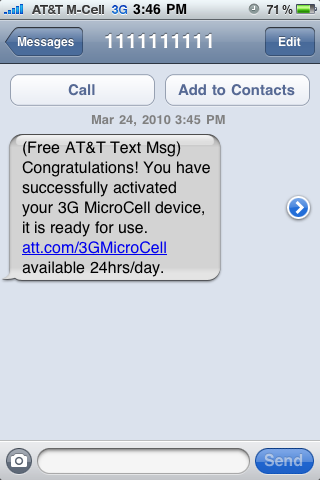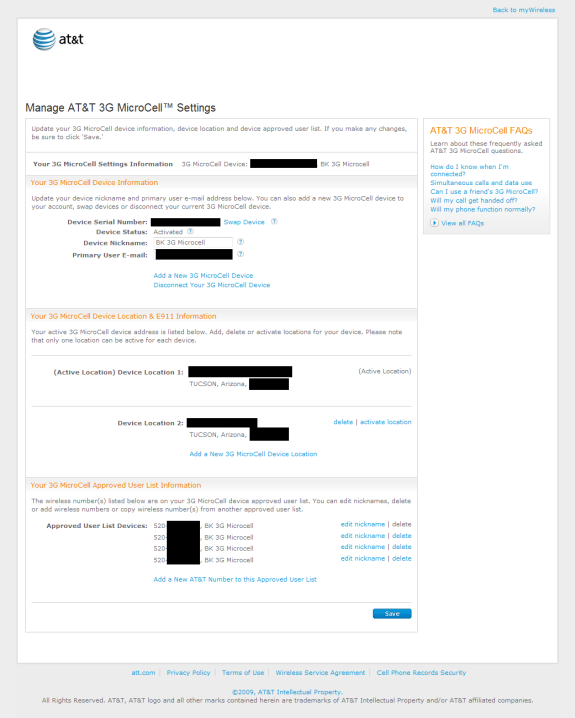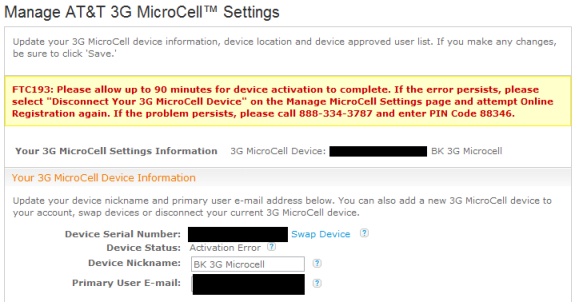AT&T 3G MicroCell: A Comprehensive Exploration
by Brian Klug on April 1, 2010 1:55 AM EST- Posted in
- Smartphones
- AT&T
- Microcell Review
- Mobile
Activating your own personal cell tower
As I mentioned earlier, there's a lot that takes place during device provisioning. Before anything is plugged in, the MicroCell has to be registered online with AT&T for both E911 and spectrum regulatory reasons. As I mentioned earlier, AT&T doesn't want to try and run the femtocell on spectrum they aren't licensed for, and there isn't uniform UMTS 850/1900 MHz licensing across the US. In my market, for example, AT&T is only licensed for the 1900 MHz spectrum.
MicroCell management - Can you micromanage a microcell?
The registration begins by prompting you to enter the device's serial number. Easy enough. Next, it asks for the physical address where the device is going to be used. I was asked for that information while I was at the store, but had to enter it again during registration. This is important because it's used for E911 as well as for verification against the GPS fix the hardware gets. Finally, you enter the approved device phone numbers that will be allowed to use the microcell. At last, you're told it's ok to plug everything in, and it's time to wait - and believe me, wait you will. This is a process that can take up to an hour, though in practice at the two locations I tested, I saw times of between 20 minutes and a 45 minutes.
There's a lot going on behind the scenes during this process, which explains why it can take some time. I noticed on my hardware during the first activation process that the device restarted cold at least once - it's highly likely there's a firmware update with security fixes and updated software that happens. It's also listening for and building a list of macrocells in range for its handoff list, adjusting its own transmission power, and collecting information about what frequencies are active in proximity. All the while trying to get a good GPS fix and provision itself on the network. After the GPS indicator is solid, the 3G indicators will flash either long pulses or very short pulses until the process is complete. Again, there's zero documentation about what long pulses versus short pulses means, but I saw alternating random patterns of both each time. The whole time, aside from the blinkenlights on the hardware, your only status page is the MicroCell management page in the screenshot above. There's very little in the way of communicating what's going on, it'll just let you know that activation is still pending, it's failed, or it's complete.
Oh noes! I didn't take it apart, I swear!
Both times I did this, at the very end of the process the status page briefly communicated that the worst had happened - activation had failed. It's confusing because you'll see the 3G light go solid and your phone join the microcell, but the page will show failed for a minute. Don't panic, look down at your phone. If everything went fine, you should now see "AT&T M-Cell" if you have an iPhone or "AT&T MicroCell" on other hardware as the carrier string:

Yes, they also send you an SMS and email with the news
It took some of my phones just a few seconds to join the microcell and show the carrier string, it took others a minute or two. I found that restarting the hardware unsurprisingly sped the process and assuaged my impatience. Now that it's working, how well does it work?












63 Comments
View All Comments
dkapke - Thursday, April 1, 2010 - link
I can't speak for what AT&Ts plans are, but I think what a lot of you aren't seeing, at least in terms of Sprint, is I LOVE their femtocell. Not because I can't get service or have crappy coverage, but because it allows UNLIMITED calls. I can get their cheapest plan, eliminate the home phone, and so long as I'm not driving between 6a-6p all of my calls are free. I work from home so this is great.So, all of you saying this is AT&Ts method of uncongesting their network - yes, that's true. But you're missing a very valid argument FOR these - unlimited calling. I guess you have to determine how often you're at home and how many minutes you use at home before night/weekend calling kicks in, but for those of us who work from home, these are awesome and well worth the $20. Oh, and when my kids come down for the summer and spend all day on the phone while they're sitting around at the house...yeah...it pays for itself very quickly.
echtogammut - Thursday, April 1, 2010 - link
They even collaborated with AT&T on this one : http://www.wireless.att.com/learn/why/3gmicrocell/...Seriously, what really gets me about this, is I installed a booster for the last company I worked with because they were not able get calls when more than 5 data phones were in the building. I called AT&T to see if I could work with them about setting up a device similar to the microcell and they transferred me to an engineer that warned me off boosting the signal. Not that long ago they called me and offered this device to fix my reception issues and charge me for another service plan... no thank you, the booster is working fine.
kamikaze56 - Thursday, April 1, 2010 - link
I agree with all you guys saying that you wont pay for a monthly cellular bill, buy your own "cell" wich uses YOUR own internet connection.. But just remember a few facts:- First of all, this device is aimed to people who have very low to zero coverage on their house/workplace and DONT want to change carrier (Or cant due to contracts), it is not aimed to people who can change their carrier at anytime..
- Second, most of the "negative" review on this article was found on location 1 (Location in urban area, with a really good coonection, crowded spectrum etc) remember, this device is aimed to locations with Zero to Really bad coverage
- 3rd and most important: Yes, you are paying your bill, you are paying by your own cell and using your own internet connection but remember, you are just using like 1/50 part of your connection in order to REACH THE CORE NETWORK, what happens in the core network and forward its still being done by the carrier (And this part of the communication process is the one that costs more), so your basically paying for using this core network. If you dont agree with this.. DONT BUY IT
kidboodah - Thursday, April 1, 2010 - link
There seems to be a misunderstanding on the pricing of this.You pay $20 a month for unlimited minutes while connected to it. This includes up to 4 simultaneous connections.
So let's say you have a 1400 FamilyTalk plan, with 4 lines. That's $109.99 per month normally. Add the Microcell and you have Unlimited talking from home for $129.99 for all lines.
Compare this to an Unlimited Family Talk plan for $70+50+50+50....and you're saving $100 a month.
It's definitely worth the initial cost for alot of customers who are on Family plans and want unlimited service from home -- while ALSO giving them full signal strength.
taltamir - Thursday, April 1, 2010 - link
there is no such thing as a radius in square feet.Square feet is used to describe the area.
Since the area of a circle is Pie*r^2 then ((5000 ft^2)/pie)^0.5 = r
or a radius of 39.89 feet
Brian Klug - Thursday, April 1, 2010 - link
Oops, that's a typo! Fixed!-Brian Klug
Ardric - Thursday, April 1, 2010 - link
The TCP and UDP ports you've listed are only used for provisioning, when the device boots. They don't carry the voice traffic. There's no use in bothering with them. Especially HTTPS -- do you really want to elevate that for your banking site too!?The voice traffic is on the IPsec tunnel, and that's carried by the ESP protocol. ESP is IP protocol 50. There's no port number.
So ignore the TCP and UDP ports and prioritize on ESP, preferably in combination with the particular AT&T IP addresses. That's how you should set up your QoS matching.
Brian Klug - Thursday, April 1, 2010 - link
You're totally right about the provisioning ports being used only for initial setup, but the device is using IPsec NAT-T, which is definitely 4500/UDP.To be honest, all my QoS rules prioritized the device in general - I'd say doing it with a static DHCP lease IP address or MAC addy makes the most sense.
Cheers,
Brian Klug
SmCaudata - Friday, April 2, 2010 - link
With T-mobile I have UMA on my phones so I can make calls anywhere I have a wireless signal. I don't need an extra box in my home AND I can use it in the deepest basement of my work.AT&T sucks. The iPhone is the ONLY thing they have going for them.
leexgx - Friday, April 2, 2010 - link
at any time did you use 2g only (set the Phone to 3g off) as i find 3g/HSDPA mostly unreliable (more so on the Iphones not so much on windows phones with HSDPA off) problem is most phone makers set the Hand over to GSM or 2g for there phones to low and i find 3g has more problems with weaker signal (if should move to 2g when signal is below 20% back to 3g when above 35%, as when 3g gets to less then 10-20% it seems to be unreliable)